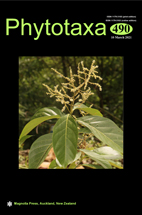Abstract
The taxonomy and nomenclature of Kalanchoe peltigera (Crassulaceae subfam. Kalanchooideae) and K. rosei var. seyrigii, a long-overlooked name published in the 1940s, are evaluated with an aim to resolve the taxonomic status and affinities of K. peltigera, which was described in the mid-2000s. In particular, the taxonomic status of K. peltigera as an accepted species is examined in detail and verified based on a comparison with other known phyllo-bulbiliferous species of Kalanchoe i.e., those species that produce bulbils on the margins of their leaf blades typically between crenations, as opposed to flori-bulbiliferous, or stoloniferous species. We show that both K. peltigera and the original description of K. rosei var. seyrigii are based on collections made of a single species from locations in close proximity in southern Madagascar. Based on an examination of living material and type specimens, as well as other herbarium accessions, of which only a limited number exist, we conclude that K. peltigera and one of the two specimens cited when K. rosei var. seyrigii was described apply to the same species. However, despite its original description, the type of the name K. rosei var. seyrigii is that of the synonym it replaced, i.e., K. rosei subsp. serratifolia, a taxon less closely related to K. peltigera, and therefore the two names are not synonymous. A morphological evaluation suggests that K. rosei is likely to be sister to K. peltigera. The name K. peltigera is neotypified as its holotype is no longer extant.

